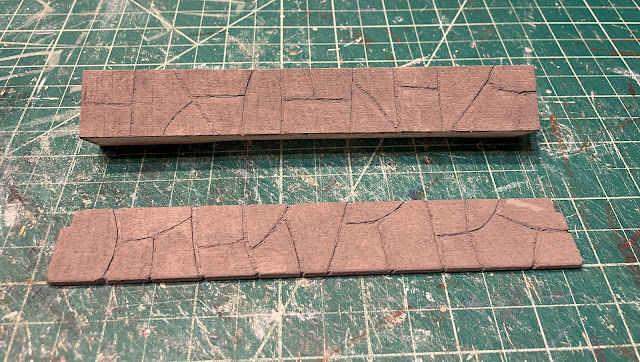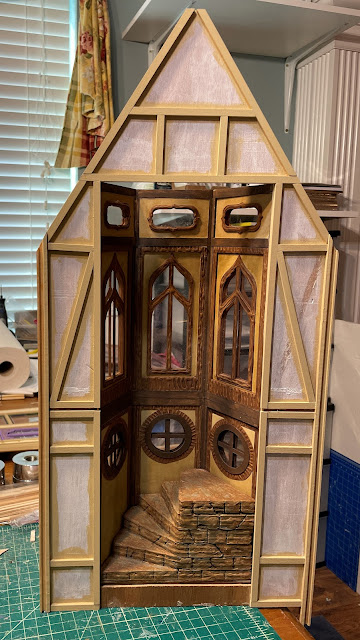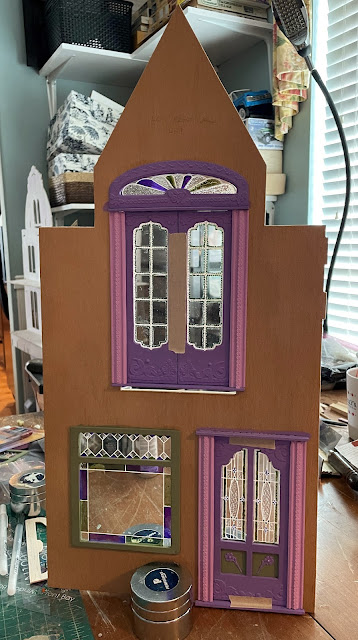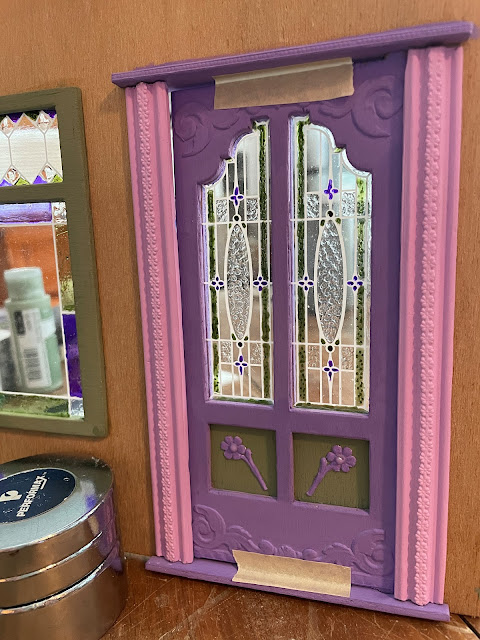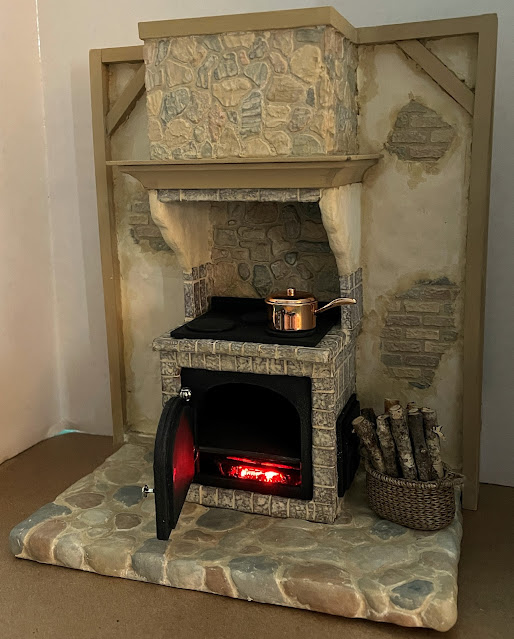This week's mini time was spent continuing on with wall prep for the fairytale treehouse. First, I needed to finish the staircase on the first wall by adding a bottom step. You can see the wall diagram in my last post. I wanted the bottom step to run the length of the stairway so that the girls had a place to sit and take off their mud boots.
I thought it best that the step be made of similar looking rocks as the rest of the staircase. And I thought it might be fun to try carving them from balsa strip wood. I constructed a simple box (from scraps) to fit between the walls, then made a separate top so that it had a slight overhang. I used a pencil to draw the grout lines that defined the rock shapes, then used an Xacto blade and a small ball stylus to carve them into the balsa.
Next, it was time to timber and stucco the the stairwell wall. I kept the design consistent with the second wall in relation to the first and second floors i.e. square frames for the first floor, angled framing for the second floor and a wainscoting style layout for the attic. I cut and glued the timbers, 1/8" x 1/4" basswood, then painted them with the same khaki color I used on most of the timbers.
I filled in between the timbers with Paperclay, then base painted and aged the edges the same as I'd done with the other walls, After I attached the first step to the stairwell wall, it was time for an exciting moment - the first dry fit of the first two walls! This is always a special moment - I finally get to see if what is making sense in my mind actually makes sense in the real world!
I love how the walls seamlessly flow into one another, but the glaring issue I saw was the unfinished floor! I really needed to make a decision on the wood floor's finish and get it done.
I decided to try using a product that I've had in my stash for a very long time. I last used it when I did a rain chain/barrel tutorial during the Three Pigs project. It's called Fred's Wood Weathering Stuff and is really great! I applied three coats to achieve the color/depth I liked, and then sealed it with satin varnish. This is exactly the treehouse floor look I had in mind!
Now it was time for another dry fit, but this time, with all the walls! Here are some views from the inside...
And here is the exterior...
You may have noticed that I also finished the timbers and stucco on the second and fourth walls' third floor wall sections. These will be seen in Wayne's third story apartment/workshop. He gets all the gables. Lucky for him he's short so the danger of him banging his head will be minimal!
Somehow, I managed to avoid doing most of the fourth wall's tasks again this week. That means I also avoided a good deal of its dizzying trim calculations! But now, out of excuses and other work, I'll have to face the music (did you know that one, Birgit?). The most challenging aspect will now be what do I affix when and in what order so that I still have great access to the wall but at the same time don't create an unforeseen issue in fitting this puzzle together. 🤪 Hopefully, next week, I'll have a fourth wall with good progress and most of my hair in tact!
Speaking of fittings... The girls received a very special package all the way from Spain! Believe it or not, it arrived in less time from across the world than my other package did from Florida! Squealing the whole time, the girls stripped off their temporary garments, helped each other put on their dresses and were ready for photos in seconds! Now, they're fit for a tea party!
The dresses are incredibly well made, so wonderfully detailed and go on and off with ease! And they aren't swimming in extra bulk and material. They fasten in the back with a crochet loop that hooks over pearl buttons. Getting their arms through the sleeves was a pleasant experience. The best part of my purchase was that I got to connect with Celia. She is the owner of the Etsy shop ChMiniatures and is an incredibly talented mini seamstress and micro crochetier! Go see her amazing needlework and drool! It also turns out that she has followed my blog for years!
And so you don't think he's gotten lost in the forest, here is Wayne! He's still as naked as the day he was born, but surprisingly, not embarrassed at all! It must be great to have that kind of confidence!
Hope you're all finding time to enjoy the things that make you happy, like the first week of spring! To my "down under" friends who are dreading fall, remember, time flies!
xo xo,
Jodi




